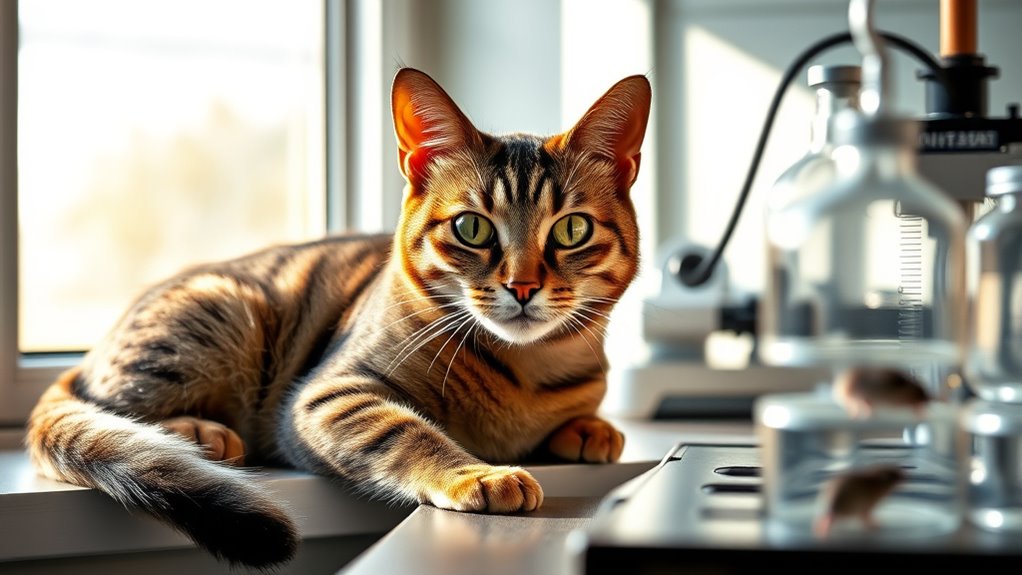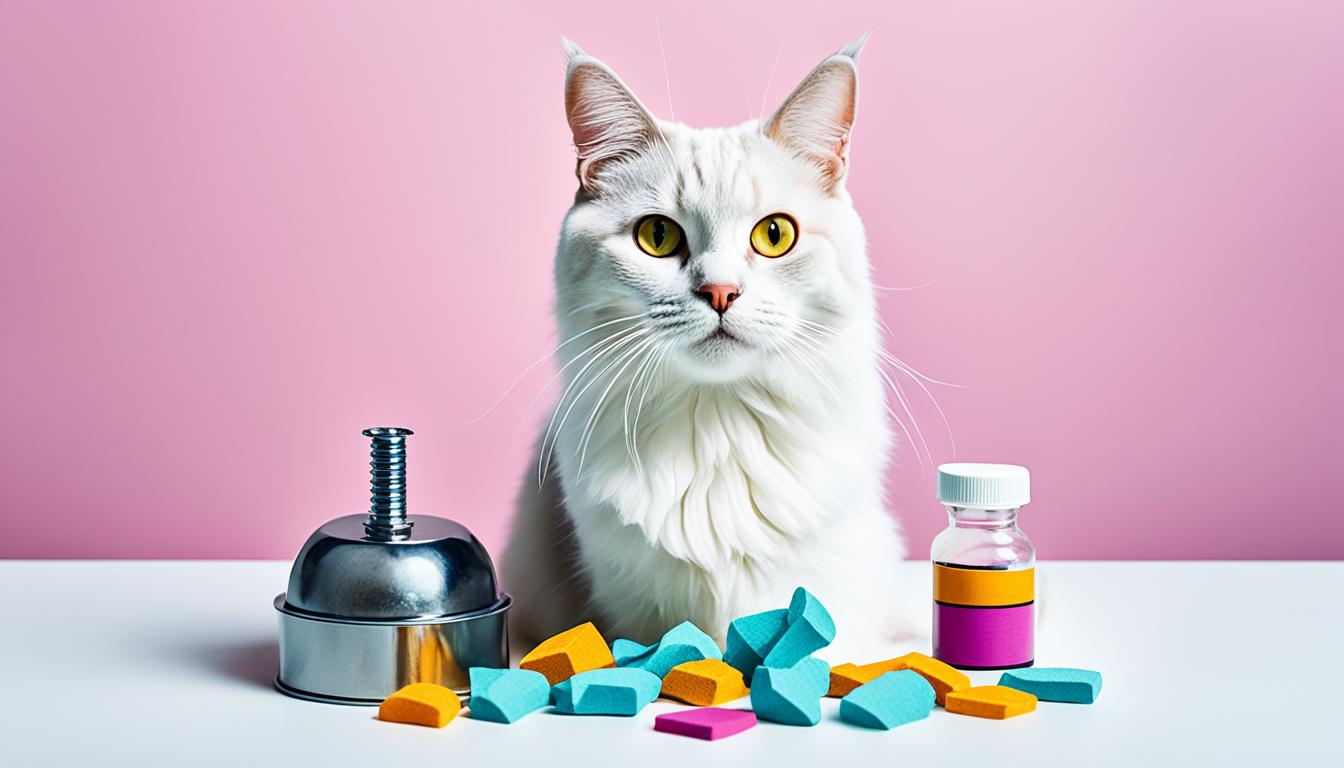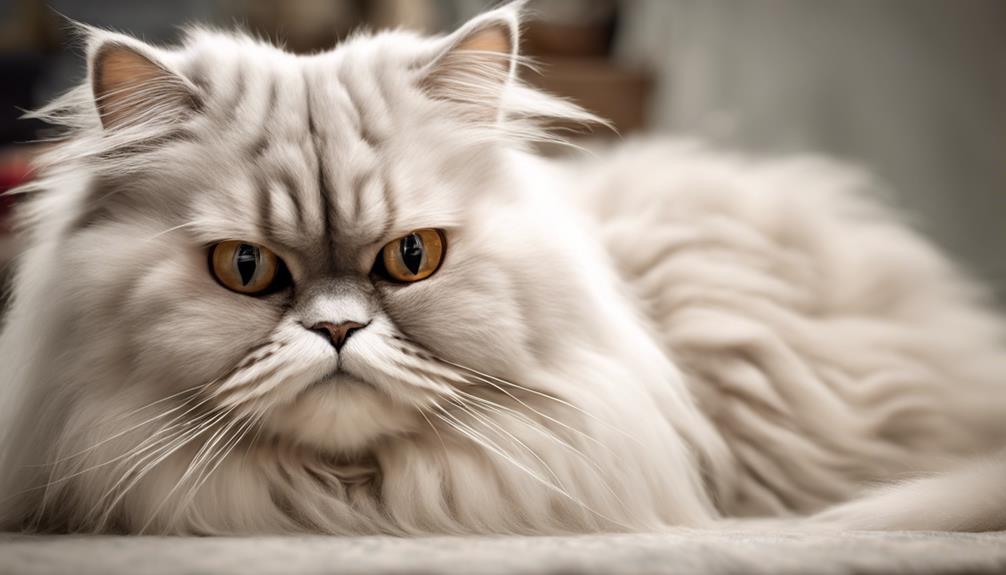Recent studies show that your cat’s purring, which vibrates within a specific frequency range (25-150 Hertz), can help speed up bone healing, as demonstrated in mice. The soothing vibrations promote tissue regeneration and reduce inflammation, potentially offering a natural way to enhance recovery. These findings suggest that harnessing purring vibrations could lead to new healing treatments. If you keep exploring, you’ll uncover more fascinating ways animal behaviors benefit health and healing.
Key Takeaways
- Studies show purring frequencies between 25-150 Hertz accelerate bone healing in mice.
- Mimicking feline purring vibrations can enhance tissue regeneration in experimental treatments.
- Purring’s calming vibrations reduce inflammation and promote cellular repair in injured tissues.
- Researchers are developing devices that replicate purring frequencies to improve healing outcomes.
- Natural cat purring demonstrates potential as a non-invasive therapy for faster bone recovery in humans.

Recent studies reveal that the soothing frequency of a cat’s purr can accelerate bone healing in humans. This discovery highlights a fascinating connection between feline behavior and potential medical benefits, offering new insights into how your pet’s natural communication might influence health. You might have noticed your cat’s purr when it’s relaxed or content, but this research suggests that those gentle vibrations could do more than just calm you—they might actively promote tissue regeneration. Understanding cat communication becomes even more intriguing as scientists explore how feline vocalizations and vibrations impact biological processes, especially in healing.
Recent research shows a cat’s purr may accelerate human bone healing through soothing vibrations.
Feline behavior, which includes a range of vocalizations, body language, and purring, serves essential functions in a cat’s life, from establishing social bonds to reducing stress. When your cat purrs, it’s not just a sign of happiness; it’s a complex form of communication that also has calming effects on humans. The specific frequency of a cat’s purr—around 25 to 150 Hertz—seems to be key in stimulating cellular activity necessary for bone repair. This frequency range is known to promote tissue regeneration and reduce inflammation, which could explain why bones heal faster when exposed to purring vibrations. Your cat’s natural behavior of purring might instinctively serve to soothe itself and others, but it turns out it may also have therapeutic advantages.
Scientists are now investigating whether mimicking these purring frequencies could develop new treatments for bone injuries. As a cat owner, you’re witnessing a form of biological communication that could someday be harnessed for medical purposes. The way cats communicate through subtle vibrations is an elegant example of how animal behavior can influence biological functions in humans. This discovery encourages a broader appreciation for feline behavior, emphasizing that your cat’s purr is more than a sign of contentment; it’s a natural tool with healing potential.
Furthermore, recent research indicates that exposure to these specific vibration frequencies can enhance cellular repair, opening new avenues for regenerative medicine. Understanding the role of cat communication in health opens new possibilities for integrating animal behavior into medical science. It’s not just about the bond you share with your pet but also about the potential for those bonds to contribute to healing processes. As research progresses, you might find yourself encouraging your cat to purr during recovery from injuries, or future therapies could involve devices that replicate these healing frequencies. Your cat’s feline behavior, especially its purring, may hold the key to accessing innovative approaches to faster recovery and tissue regeneration, illustrating how the natural communication between species can have extraordinary benefits.
Frequently Asked Questions
Can Humans Benefit From Cat Purr Frequencies for Healing?
You might wonder if humans can benefit from cat purr frequencies for healing. While feline communication has intrigued scientists, current veterinary applications focus on understanding how purring promotes healing in animals. Although research shows purring can aid bone repair in mice, there’s no direct evidence it works the same for humans. Still, studying these frequencies could open new therapies, but more research is needed before you can rely on purring for healing.
Are Specific Cat Breeds More Effective for Healing Purposes?
Imagine each breed as a unique brushstroke on the canvas of feline physiology. While breed-specific healing isn’t conclusively proven, some breeds may naturally produce purrs at frequencies more effective for healing. You should consider that certain breeds, like the Ragdoll or Maine Coon, might have subtle differences affecting their purrs’ therapeutic potential, making breed-specific healing a fascinating area for future research.
How Does the Purr Frequency Compare to Other Sound Therapies?
You’re curious about how purr frequency stacks up against other sound therapies. Sound therapy often uses specific frequencies to promote healing, relaxation, or pain relief. The cat’s purr frequency, around 25-50 Hz, is unique because studies show it can stimulate bone growth. When you compare it to other sound therapies, you’ll see it’s particularly effective for bone healing, making it stand out due to its natural, soothing vibrations.
Is There a Risk of Negative Effects From Exposure to Purr Frequencies?
You might wonder if exposure to purr frequencies causes potential hearing damage or triggers stress or anxiety. While the soothing sound is generally safe, prolonged or very loud exposure could potentially lead to hearing damage. Some individuals might also experience stress or anxiety if they find the sound irritating or disruptive. It’s wise to enjoy purring sounds in moderation and at comfortable volumes to avoid negative effects.
Could This Discovery Lead to New Medical Treatments for Bone Injuries?
Imagine a whisper from a feline healer guiding your bones to mend faster. This discovery suggests that cat vocalizations, specifically purr frequencies, could pioneer new medical treatments for bone injuries. Feline therapy might harness these soothing sounds to accelerate healing, transforming recovery. While promising, you’ll need extensive research to guarantee safety and effectiveness. Still, it’s an exciting step toward innovative, nature-inspired solutions for medical science.
Conclusion
Your connection to a cat’s purr isn’t just comfort—it’s a symbol of healing. Just as the gentle vibration can accelerate bone repair in mice, it reminds you that nature’s subtle rhythms hold powerful secrets. Embrace these quiet melodies, for they symbolize hope and renewal. When you listen closely, you realize healing isn’t only physical; it’s a harmony waiting to be uncovered within you. Sometimes, the softest sounds carry the loudest promise of recovery.










